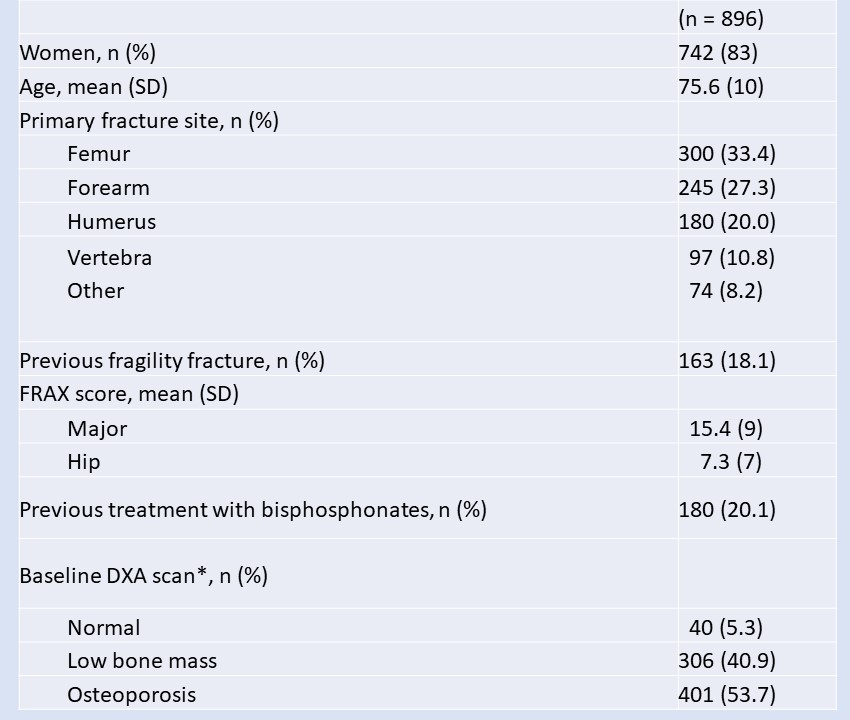Session Information
Session Type: Poster Session A
Session Time: 9:00AM-11:00AM
Background/Purpose: Data on the effectiveness of FLS in the medium and long term are needed. The objetive of this study was to analyze the indicators of long-term persistence to treatment, refracture and mortality in our Fracture Liaison Service (FLS)
Methods: We review the medical records of patients with an indication of treatment to prevent new fractures (bisphosphonate -BP- or equivalent) whose baseline visit took place between 2012 and 2016. The data included those of the baseline visit (age, sex, type of index fracture, FRAX scale and DXA results) and for the follow-up (death and date, refracture including revision of spine x-rays – it was considered only the first refracture and, in the case of several fractures the most serious was chosen-, prescribed treatment, persistence of treatment trough electronic prescription on the date of review or death, and MPR or proportion of days covered by treatment).
Results: 896 patients were included, with an average follow-up of 63,6 months (DE 29, range 42-90). Table 1 shows the baseline characteristics.
Follow-up.- The persistence of treatment was assessed in 888 patients; 618 patients (69.6%) were prescribed a treatment at any time, 480 of them (77,9%) with a MPR≥80% at the time of chart review or death (in that case). Therefore, 54% of the analyzed patients persist with the treatment defined as MPR > 80%.
When analyzing patients with prescribed treatment, in 378 cases (61.1%) it was a BP in a sustained manner, in 85 cases (13.7%) a BP was prescribed and subsequently changed to denosumab, while in 151 cases (24,4%) it was initiated and maintained denosumab, and 4 patients other treatments. The MPR > 80% was 75% in patients who started and maintained BP, 79% in those who started BP and switched to denosumab, and 87% in those who had denosumab throughout the analysis period.
138 of 891 pacients (15,4%) had a new fracture, 112 a major fracture (12,5%) and 50 hip fracture (5,6%). Taking the 6-year period, 42% of refractures occurred in the first two years after the index fracture.
In patients without a prescribed treatment, refracture ocurred in 15,1% (major and hip fractures in 12.9% and 8.5%). In patients with a prescribed treatment refractures ocurred in 15,7% (major and hip fractures in 12.5% and 4.3%). Compared to patients without treatment we found a significant lower incidence of hip fracture in patients wit a prescribed treatment (OR 0.49, CI 95% 0.20-0.79) but a similar incidence of major fracture, mean FRAX (15.8 vs 14.4) and age (75.4 vs 76.2).
212 patients (23.6%) died. Compared to those alive, in patients who died we found a higher age (81 vs 74), a higher frequence of hip fracture at baseline (52% vs 27%), a higher hip refracture (9.4% vs 4.4%) and a lower prescription of treatment (56.4% vs 73,6%).
Conclusion: 6 years after the assessment in an FLS, the persistence of treatment with MPR≥80% was 54%. We found an association with prescription of treatment with lower hip refracture.
 Table 1. Baseline characteristics of patients Abbreviations: SD, standard deviation; DXA, dual energy X-ray absorptiometry , *analysed in 747 patients
Table 1. Baseline characteristics of patients Abbreviations: SD, standard deviation; DXA, dual energy X-ray absorptiometry , *analysed in 747 patients
To cite this abstract in AMA style:
Naranjo Hernandez A, Molina A, Sepúlveda C, Rubiño F, Quevedo A, Ojeda S. Indicators of Effectiveness After 6 Years of Follow-up in a Fracture Liaison Service [abstract]. Arthritis Rheumatol. 2020; 72 (suppl 10). https://acrabstracts.org/abstract/indicators-of-effectiveness-after-6-years-of-follow-up-in-a-fracture-liaison-service/. Accessed .« Back to ACR Convergence 2020
ACR Meeting Abstracts - https://acrabstracts.org/abstract/indicators-of-effectiveness-after-6-years-of-follow-up-in-a-fracture-liaison-service/
